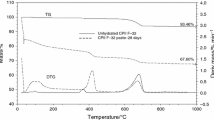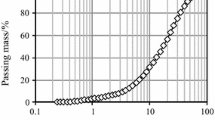Abstract
Calorimetry was applied to follow the hydration of special cement mixtures exhibiting expansion or shrinkage compensation. The standard, common cements show generally less or more visible shrinkage on setting and hardening but mixed with and expansive agent, usually of aluminate and sulfate nature, they can exhibit the increase of volume. The calcium aluminate cement CAC 40 was ground together with special sulfate–lime sinter to produce an expansive additive to Portland cement (CEM I 42.5R). The expansive additive in the environment of hydrating cement transforms into ettringite at “right time” to give expansion before the final setting and hardening takes place. In the experiments the proportions of components of expansive mixture and basic cement were variable. The rate of hydration versus time for common cements is commonly known and reflects the moderate setting and early hardening during the first days after mixing with water (two peaks and the induction period between them). The aim of measurements presented in this study was to show the course of heat evolution curve and the heat evolved values, equivalent to the acceleration/retardation of hydration, in case of the paste with the expansive mixture, as well as the pastes produced from Portland cement and the components of expansive additives added in variable proportions. It was possible to see how the calorimetric curve and consequently the hydration process itself declines from the controlled setting/hardening. These measurements were supplied by the examples of phase composition studies by XRD.








Similar content being viewed by others
References
Pacewska B, Błonkowski G, Wilińska I. Studies on the pozzolanic and hydraulic properties of fly ashes in model systems. J Therm Anal Cal. 2008;94:469.
Nocuń-Wczelik W. Calorimetry in the studies of cement–Pb compounds interaction. J Therm Anal Cal. 2007;88:291.
Talero R, Rahhal V. Calorimetric comparison of portland cements containing silica fume and metakaolin. Is silica fume, like metakaolin, characterized by pozzolanic activity that is more specific than generic? J Therm Anal Cal. 2009;96:383.
Odler I. Special inorganic cements. London, New York: Taylor & Francis; 2000. p. 316.
Mehta PK, Polivka M. Expansive cements. Proc of the Sixth Int Congr Chem Cem. Moscow; 1974; 3: p.158.
ASTM C845 standard specification for expansive hydraulic cement. ASTM International, West Conshohocken; 2004.
Kurdowski W. Chemistry of cement. Warsaw: PWN editor; 1991. p. 415 (in Polish).
Odler I, Subauste CJ. Stresses generated in expansive reactions of cementitious systems. Cem Concr Res. 2002;32:117.
Szeląg H. Factors governing the stresses appearing in the mortars of expansive cement. Part 1 and 2. Cement - Wapno - Beton 2008;13/75:315. 2009;14/76:11.
Konik Z, Małolepszy J, Roszczynialski W, Stok A. Production of expansive additive to portland cement. J Eur Ceram Soc. 2007;27:605.
Nocuń-Wczelik W, Konik Z, Stok A. Blended systems with calcium aluminate and calcium sulphate expansive additives. 11th International Conference and Exhibition o the European Ceramic Society ECERS 2009. Book of abstracts. p. 206. to be published.
Gawlicki M, Nocuń-Wczelik W, Bąk Ł. Calorimetry in the studies of cement hydration. Setting and hardening of Portland cement–calcium aluminate cement mixtures. J Therm Anal Cal. 2009. on-line.
Gu P, Beaudoin JJ, Quinn EG, Myers RE. Early strength development and hydration of ordinary Portland cement/calcium aluminate cement pastes. Adv Cem Bas Mat. 1997;6:53.
Acknowledgements
The experimental support of Łukasz Nowak and Karolina Leżuch is appreciated. The financial support from the Ministry of Education and Science in Poland (grant No: N N507 450934; AGH - 18.18.160.692) is acknowledged.
Author information
Authors and Affiliations
Corresponding author
Rights and permissions
About this article
Cite this article
Nocuń-Wczelik, W., Stok, A. & Konik, Z. Heat evolution in hydrating expansive cement systems. J Therm Anal Calorim 101, 527–532 (2010). https://doi.org/10.1007/s10973-010-0846-1
Published:
Issue Date:
DOI: https://doi.org/10.1007/s10973-010-0846-1




